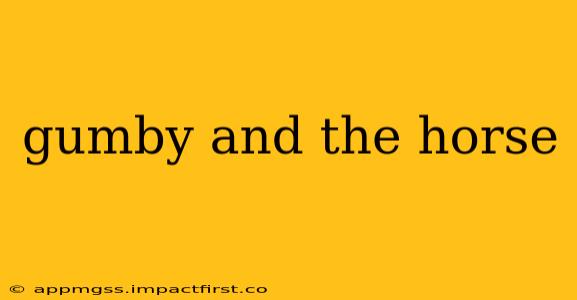Gumby and the Horse: Exploring the Classic Claymation Duo
Gumby, the incredibly pliable green claymation character, and his trusty steed, a surprisingly expressive horse, have delighted generations. Their adventures, simple yet charming, have cemented their place in animation history. This exploration delves into their relationship, the impact of their shows, and answers some frequently asked questions surrounding these beloved figures.
What kind of horse was Gumby's horse?
While never explicitly stated in the shows, Gumby's horse is generally considered a generic horse, perhaps a pony due to its size relative to Gumby. The animation style doesn't adhere to strict anatomical accuracy; the horse's design is more focused on expressiveness and comedic effect than realistic representation. Its coloring often varied across different episodes and production eras, further highlighting the flexibility of its claymation form.
What were Gumby and his horse's names?
Gumby's name is, of course, Gumby. However, his horse doesn't have a consistently used name within the show itself. He's often simply referred to as "the horse," or sometimes just "horse." This lack of a specific name adds to his character's simplistic charm and reinforces the focus on Gumby as the main protagonist. The absence of a name also allows viewers to form their own connection and personal interpretation of the character.
Who created Gumby and his horse?
The ingenious mind behind Gumby and his equine companion is Art Clokey. A pioneer in claymation techniques, Clokey not only created the characters but also directed and produced many of their early adventures. His innovative approach to animation helped establish claymation as a viable and beloved form of storytelling for both children and adults. The distinctive look and feel of Gumby and his horse are directly attributable to Clokey's creative vision and groundbreaking animation style.
What made Gumby and his horse so popular?
The enduring appeal of Gumby and his horse stems from several key factors:
- Simple, yet engaging storytelling: The adventures were often straightforward, focusing on everyday situations and simple morals. This simplicity made them easily accessible to young viewers.
- The charm of claymation: The unique aesthetic of claymation, with its slightly imperfect and tactile quality, lent a distinct charm to the characters and their world. This differs significantly from the smooth lines of other animation styles of the time.
- The relatable characters: While fantastical in their ability to bend and stretch, Gumby and his horse possessed endearing qualities that resonated with audiences. Their interactions were often humorous and relatable, fostering a sense of connection with viewers.
- Nostalgia factor: For many, Gumby and his horse represent cherished memories of childhood, further cementing their legacy in popular culture.
How did Gumby's horse contribute to the show's success?
Gumby's horse is more than just a mode of transportation; he's a crucial supporting character. His often-expressive features, despite the limitations of claymation, add a dimension of humor and emotional depth to the show. The horse's reactions and interactions with Gumby greatly enhance the comedic timing and overall storytelling, making him an integral part of the show's success.
The legacy of Gumby and his horse extends far beyond the original television series. They've appeared in various media over the years, highlighting the timeless appeal of these unique and charming characters. Their enduring popularity speaks volumes about the effectiveness of simple storytelling, memorable characters, and the undeniable charm of classic claymation.
